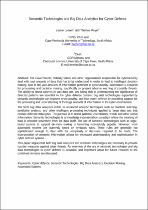JavaScript is disabled for your browser. Some features of this site may not work without it.
- ResearchSpace
- →
- Research Publications/Outputs
- →
- Journal Articles
- →
- View Item
| dc.contributor.author |
Leenen, L

|
|
| dc.contributor.author |
Meyer, T

|
|
| dc.date.accessioned | 2017-02-03T08:36:22Z | |
| dc.date.available | 2017-02-03T08:36:22Z | |
| dc.date.issued | 2016-07 | |
| dc.identifier.citation | Leenen, L. and Meyer, T. 2016. Semantic technologies and big data analytics for cyber defence. International Journal of Cyber Warfare and Terrorism (IJCWT), 6(3), pp1-12 | en_US |
| dc.identifier.issn | 1947-3443 | |
| dc.identifier.uri | http://www.igi-global.com/article/semantic-technologies-and-big-data-analytics-for-cyber-defence/159884 | |
| dc.identifier.uri | http://hdl.handle.net/10204/8932 | |
| dc.description | Copyright: 2016 IGI Global | en_US |
| dc.description.abstract | The Governments, military forces and other organisations responsible for cybersecurity deal with vast amounts of data that has to be understood in order to lead to intelligent decision making. Due to the vast amounts of information pertinent to cybersecurity, automation is required for processing and decision making, specifically to present advance warning of possible threats. The ability to detect patterns in vast data sets, and being able to understanding the significance of detected patterns are essential in the cyber defence domain. Big data technologies supported by semantic technologies can improve cybersecurity, and thus cyber defence by providing support for the processing and understanding of the huge amounts of information in the cyber environment. The term big data analytics refers to advanced analytic techniques such as machine learning, predictive analysis, and other intelligent processing techniques applied to large data sets that contain different data types. The purpose is to detect patterns, correlations, trends and other useful information. Semantic technologies is a knowledge representation paradigm where the meaning of data is encoded separately from the data itself. The use of semantic technologies such as logic-based systems to support decision making is becoming increasingly popular. However, most automated systems are currently based on syntactic rules. These rules are generally not sophisticated enough to deal with the complexity of decisions required to be made. The incorporation of semantic information allows for increased understanding and sophistication in cyber defence systems. This paper argues that both big data analytics and semantic technologies are necessary to provide counter measures against cyber threats. An overview of the use of semantic technologies and big data technologies in cyber defence is provided, and important areas for future research in the combined domains are discussed. | en_US |
| dc.language.iso | en | en_US |
| dc.publisher | IGI Global | en_US |
| dc.relation.ispartofseries | Wokflow;17331 | |
| dc.subject | Cyber warfare | en_US |
| dc.subject | Semantic technologies | en_US |
| dc.subject | Automated systems | en_US |
| dc.subject | Big data analytics | en_US |
| dc.subject | Cyber defence | en_US |
| dc.subject | Semantic technologies | en_US |
| dc.title | Semantic technologies and big data analytics for cyber defence | en_US |
| dc.type | Article | en_US |
| dc.identifier.apacitation | Leenen, L., & Meyer, T. (2016). Semantic technologies and big data analytics for cyber defence. http://hdl.handle.net/10204/8932 | en_ZA |
| dc.identifier.chicagocitation | Leenen, L, and T Meyer "Semantic technologies and big data analytics for cyber defence." (2016) http://hdl.handle.net/10204/8932 | en_ZA |
| dc.identifier.vancouvercitation | Leenen L, Meyer T. Semantic technologies and big data analytics for cyber defence. 2016; http://hdl.handle.net/10204/8932. | en_ZA |
| dc.identifier.ris | TY - Article AU - Leenen, L AU - Meyer, T AB - The Governments, military forces and other organisations responsible for cybersecurity deal with vast amounts of data that has to be understood in order to lead to intelligent decision making. Due to the vast amounts of information pertinent to cybersecurity, automation is required for processing and decision making, specifically to present advance warning of possible threats. The ability to detect patterns in vast data sets, and being able to understanding the significance of detected patterns are essential in the cyber defence domain. Big data technologies supported by semantic technologies can improve cybersecurity, and thus cyber defence by providing support for the processing and understanding of the huge amounts of information in the cyber environment. The term big data analytics refers to advanced analytic techniques such as machine learning, predictive analysis, and other intelligent processing techniques applied to large data sets that contain different data types. The purpose is to detect patterns, correlations, trends and other useful information. Semantic technologies is a knowledge representation paradigm where the meaning of data is encoded separately from the data itself. The use of semantic technologies such as logic-based systems to support decision making is becoming increasingly popular. However, most automated systems are currently based on syntactic rules. These rules are generally not sophisticated enough to deal with the complexity of decisions required to be made. The incorporation of semantic information allows for increased understanding and sophistication in cyber defence systems. This paper argues that both big data analytics and semantic technologies are necessary to provide counter measures against cyber threats. An overview of the use of semantic technologies and big data technologies in cyber defence is provided, and important areas for future research in the combined domains are discussed. DA - 2016-07 DB - ResearchSpace DP - CSIR KW - Cyber warfare KW - Semantic technologies KW - Automated systems KW - Big data analytics KW - Cyber defence KW - Semantic technologies LK - https://researchspace.csir.co.za PY - 2016 SM - 1947-3443 T1 - Semantic technologies and big data analytics for cyber defence TI - Semantic technologies and big data analytics for cyber defence UR - http://hdl.handle.net/10204/8932 ER - | en_ZA |






